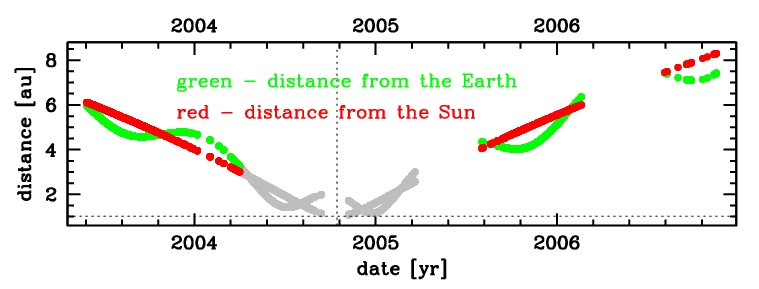| Solar System Dynamics & Planetology Group |
 |
C/2003 K4 LINEAR |  |
| Solar System Dynamics & Planetology Group |
 |
C/2003 K4 LINEAR |  |

| number of observations | 3658 |
| number of residuals | 7245 |
| data interval | 2003 May 28 — 2006 Nov. 17 |
| rms [arcsec] | 0.46 |
| orbit quality class | 1a+ |
| Epoch (TT) | 20030501.0 | = JD 2452760.5 |
| time of perihelion passage (TT) | 20041013.697058 | ± 0.000024 |
| perihelion distance | 1.02406159 | ± 0.00000046 |
| eccentricity | 1.00043406 | ± 0.00000053 |
| argument of perihelion [deg] | 198.404190 | ± 0.000036 |
| longitude of the ascending node [deg] | 18.651630 | ± 0.000009 |
| inclination [deg] | 134.247399 | ± 0.000003 |
| inverse semimajor axis [10-6 au-1] | -423.86 | ± 0.52 |
| Nongravitational parameters [10-8 au/day2] | A1 = 0.8522 ± 0.0171 | A2 = -0.43620 ± 0.00607 | A3 = -0.06644 ± 0.00432 |
| Epoch (TT) | 17060319 | |
| time of perihelion passage (TT) | 20041013.574142 | ± 0.000025 |
| perihelion distance | 1.02053946 | ± 0.00000046 |
| eccentricity | 0.99996796 | ± 0.00000052 |
| argument of perihelion [deg] | 198.550756 | ± 0.000036 |
| longitude of the ascending node [deg] | 18.663783 | ± 0.000009 |
| inclination [deg] | 134.279113 | ± 0.000003 |
| inverse semimajor axis [10-6 au-1] | 31.39 | ± 0.51 |
| Epoch (TT) | 23010827 | |
| time of perihelion passage (TT) | 20041013.151808 | ± 0.000033 |
| perihelion distance | 1.02157402 | ± 0.00000047 |
| eccentricity | 1.00012172 | ± 0.00000078 |
| argument of perihelion [deg] | 198.400305 | ± 0.000037 |
| longitude of the ascending node [deg] | 18.727274 | ± 0.000009 |
| inclination [deg] | 134.215507 | ± 0.000008 |
| inverse semimajor axis [10-6 au-1] | -119.15 | ± 0.76 |
| number of observations | 1838 (observations at large distances from the Sun) |
| number of residuals | 3632 |
| data interval | 2003 May 28 — 2006 Nov. 17 |
| rms [arcsec] | 0.44 |
| orbit quality class | 1a+ |
| Epoch (TT) | 20030501.0 | = JD 2452760.5 |
| time of perihelion passage (TT) | 20041013.706563 | ± 0.000658 |
| perihelion distance | 1.02405532 | ± 0.00000118 |
| eccentricity | 1.00041390 | ± 0.00000162 |
| argument of perihelion [deg] | 198.405628 | ± 0.000089 |
| longitude of the ascending node [deg] | 18.651602 | ± 0.000033 |
| inclination [deg] | 134.247433 | ± 0.000008 |
| inverse semimajor axis [10-6 au-1] | -404.18 | ± 1.58 |
| Nongravitational parameters [10-8 au/day2] | A1 = 0.3299 ± 0.0407 | A2 = 0.1058 ± 0.0256 | A3 = -0.1252 ± 0.0148 |
| Epoch (TT) | 17051229 | |
| time of perihelion passage (TT) | 20041013.583724 | ± 0.000667 |
| perihelion distance | 1.02053316 | ± 0.00000119 |
| eccentricity | 0.99994788 | ± 0.00000163 |
| argument of perihelion [deg] | 198.552191 | ± 0.000090 |
| longitude of the ascending node [deg] | 18.663745 | ± 0.000034 |
| inclination [deg] | 134.279144 | ± 0.000008 |
| inverse semimajor axis [10-6 au-1] | 51.07 | ± 1.60 |
| Epoch (TT) | 23001230 | |
| time of perihelion passage (TT) | 20041013.162810 | ± 0.000728 |
| perihelion distance | 1.02158994 | ± 0.00000199 |
| eccentricity | 1.00018592 | ± 0.00000261 |
| argument of perihelion [deg] | 198.403591 | ± 0.000193 |
| longitude of the ascending node [deg] | 18.727300 | ± 0.000021 |
| inclination [deg] | 134.215649 | ± 0.000022 |
| inverse semimajor axis [10-6 au-1] | -182.00 | ± 2.56 |